Natural Groundwater Recharge Response to Climate Variability and Land Cover Change Perturbations in Basins with Contrasting Climate and Geology in Tanzania
Abstract
:1. Background Information
2. Description of the Study Areas
2.1. Climate
2.2. Geology
3. Materials and Methods
3.1. The Modified Soil Moisture Balance Method Coupled with Curve Number for Recharge Assessment
3.2. Runoff Estimation Using the Modified Curve Number Method
3.3. Land Use Land Cover (LULC) Classification
3.4. Hydrological Soil Groups
3.5. Antecedent Moisture Condition
3.6. Estimation of Weighted Curve Numbers for Kimbiji and Singida Aquifers
3.7. Potential Evapotranspiration
3.8. Assessing the Influence of El Nino and the Southern Oscillation on Rainfall and Recharge Using the Southern Oscillation Index
- Pdiff = [Average Tahiti Mean Sea Level Pressure (MSLP) for the month] − [Average Darwin Mean Sea Level Pressure (MSLP) for the month];
- Pdiffav = Long term average of Pressure difference (Pdiff) for the month in question;
- SD (Pdiff) = Long term standard deviation of Pdiff for the month in question.
4. Results
4.1. Land Cover Change Assessment
4.2. Assessment of the Magnitude and Annual Rate of Land Cover Changes
4.3. Land Cover Classification Accuracy Assessment
4.4. The Weighted Curve Numbers for the Kimbiji and Singida Aquifers
4.5. Potential Evapotranspiration, Rainfall, Runoff, Groundwater Recharge, and Aridity Indices
4.6. Groundwater Recharge Response to Climate and Land Cover Dynamics
5. Discussion
6. Conclusions
Author Contributions
Funding
Data Availability Statement
Acknowledgments
Conflicts of Interest
References
- Crosbie, R.; McCallum, J.; Walker, G.; Chiew, F. Episodic recharge and climate change in the Murray-Darling Basin, Australia. Hydrogeol. J. 2012, 20, 245–261. [Google Scholar] [CrossRef]
- Dowlatabadi, S.; Zomorodian, S.A. Conjunctive simulation of surface water and groundwater using SWAT and MODFLOW in Firoozabad watershed. KSCE J. Civ. Eng. 2016, 20, 485–496. [Google Scholar] [CrossRef]
- Polemio, M. Monitoring and management of karstic coastal groundwater in a changing environment (Southern Italy): A review of a regional experience. Water 2016, 8, 148. [Google Scholar] [CrossRef] [Green Version]
- Sharma, M.L. Measurement and prediction of natural groundwater recharge--an overview. J. Hydrol. 1986, 25, 49–56. [Google Scholar]
- Natkhin, M.; Dietrich, O.; Schäfer, M.P.; Lischeid, G. The effects of climate and changing land use on the discharge regime of a small catchment in Tanzania. Reg. Environ. Chang. 2013, 15, 1269–1280. [Google Scholar] [CrossRef]
- Bonan, G. Effects of land use on the climate of United States. Clim. Chang. 1997, 37, 449–486. [Google Scholar] [CrossRef]
- Pielke, R.A.; Avissar, R.; Raupach, M.; Dolman, H.; Zeng, X.; Denning, S. Interactions between the atmosphere and terrestrial ecosystems: Influence on weather and climate. Glob. Chang. Biol. 1998, 4, 461–475. [Google Scholar] [CrossRef]
- Sterling, S.M.; Ducharne, A.; Polcher, J. The impact of global land-cover change on the terrestrial water cycle. Nat. Clim. Chang. 2013, 3, 385–390. [Google Scholar] [CrossRef]
- Vazquez-Amábile, G.G.; Engel, B.A. Use of SWAT to Compute Groundwater Table Depth and Streamflow in the Muscatatuck River Watershed. Am. Soc. Agric. Eng. 2015, 48, 991–1003. [Google Scholar] [CrossRef] [Green Version]
- Nobert, J.; Jeremiah, J. Hydrological Response of Watershed Systems to Land Use/Cover Change. A Case of Wami River Basin. Open Hydrol. J. 2012, 6, 78–87. [Google Scholar] [CrossRef]
- Notter, B.; Hans, H.; Wiesmann, U.; Ngana, J.O. Evaluating watershed service availability under future management and climate change scenarios in the Pangani Basin Phys. Chem. Earth 2013, 61, 1–11. [Google Scholar] [CrossRef]
- Wambura, F.J.; Ndomba, P.M.; Kongo, V.; Tumbo, S.D. Uncertainty of runoff projections under changing climate in Wami River sub-basin. J. Hydrol. Reg. Stud. 2015, 4, 333–348. [Google Scholar] [CrossRef] [Green Version]
- Mbungu, W.B.; Kashaigili, J.J. Assessing the Hydrology of a Data-Scarce Tropical Watershed Using the Soil and Water Assessment Tool: Case of the Little Ruaha River Watershed in Iringa, Tanzania. Open J. Mod. Hydrol. 2017, 07, 65–89. [Google Scholar] [CrossRef] [Green Version]
- Mutayoba, E.; Kashaigili, J.J.; Kahimba, F.C.; Mbungu, W.; Chilagane, N.A. Assessment of the Impacts of Climate Change on Hydrological Characteristics of the Mbarali River Sub Catchment Using High Resolution Climate Simulations from CORDEX Regional Climate Models. Appl. Phys. Res. 2018, 10, 61. [Google Scholar] [CrossRef] [Green Version]
- Twisa, S.; Kazumba, S.; Kurian, M.; Buchroithner, M.F. Evaluating and predicting the effects of land use changes on hydrology in Wami river basin, Tanzania. Hydrology 2020, 7, 17. [Google Scholar] [CrossRef] [Green Version]
- Chilagane, N.A.; Kashaigili, J.J.; Mutayoba, E. Historical and Future Spatial and Temporal Changes in Land Use and Land Cover in the Little Ruaha River Catchment, Tanzania. J. Geosci. Environ. Prot. 2020, 8, 76–96. [Google Scholar] [CrossRef] [Green Version]
- Lwimbo, Z.D.; Komakech, H.C.; Muzuka, A.N.N. Estimating groundwater recharge on the southern slope of Mount Kilimanjaro, Tanzania. Environ. Earth Sci. 2019, 78, 1–22. [Google Scholar] [CrossRef]
- Olarinoye, T.; Foppen, J.W.; Veerbeek, W.; Morienyane, T.; Komakech, H. Exploring the future impacts of urbanization and climate change on groundwater in Arusha, Tanzania. Water Int. 2020, 45, 497–511. [Google Scholar] [CrossRef]
- Oke, M.O.; Martins, O.; Idowu, O.A. Determination of rainfall-recharge relationship in River Ona basin using soil moisture balance and water fluctuation methods. Int. J. Water Resour. Environ. Eng. 2014, 6, 1–11. [Google Scholar] [CrossRef] [Green Version]
- Guzha, A.C.; Rufino, M.C.; Okoth, S.; Jacobs, S.; Nóbrega, R.L.B. Impacts of land use and land cover change on surface runoff, discharge and low flows: Evidence from East Africa. J. Hydrol. Reg. Stud. 2018, 15, 49–67. [Google Scholar] [CrossRef]
- Mussa, K.R.; Mjemah, I.C.; Machunda, R.L. Open-source software application for hydrogeological delineation of potential groundwater recharge zones in the Singida semi-arid, fractured aquifer, central Tanzania. Hydrology 2020, 7, 28. [Google Scholar] [CrossRef]
- Kent, P.E.; Hunt, J.A.; Johnstone, D.W. The Geology and Geophysics of Coastal Tanzania; Institute of Geological Sciences Geophysical Paper No. 6; HMSO: London, UK, 1971. [Google Scholar]
- Thornthwaite, C.W. An approach toward a rational classification of climate. Geogr. Rev. 1948, 38, 55–94. [Google Scholar] [CrossRef]
- Thornthwaite, C.W.; Mather, J.R. Instructions and tables for computing potential evapotranspiration and the water balance. Publ. Climatol. 1957, 10, 183–311. [Google Scholar]
- Mishra, S.K.; Jain, M.K.; Singh, V.P. Evaluation of the SCS-CN-based model incorporating antecedent moisture. Water Resour. Manag. 2004, 18, 567–589. [Google Scholar] [CrossRef]
- Nugroho, A.R.; Tamagawa, I.; Riandraswari, A.; Febrianti, T. Thornthwaite-Mather water balance analysis in Tambakbayan watershed, Yogyakarta, Indonesia. MATEC Web Conf. 2019, 280, 05007. [Google Scholar] [CrossRef] [Green Version]
- Satheeshkumar, S.; Venkateswaran, S.; Kannan, R. Rainfall–runoff estimation using SCS–CN and GIS approach in the Pappiredipatti watershed of the Vaniyar sub basin, South India. Modeling Earth Syst. Environ. 2017, 3, 1–8. [Google Scholar] [CrossRef] [Green Version]
- Vinithra, R.; Yeshodha, L. Rainfall-Runoff Modelling Using SCS-CN Method: A Case Study of Krishnagiri District, Tamilnadu. Int. J. Sci. Res. 2016, 5, 2080–2084. [Google Scholar] [CrossRef]
- McCabe, G.J.; Markstrom, S.L. A Monthly Water-Balance Model Driven by a Graphical User Interface; U.S. Geological Survey Open-File Report: Reston, VA, USA, 2007; Volume 1088, p. 6.
- Bakundukize, C.; van Camp, M.; Walraevens, K. Estimation of Groundwater Recharge in Bugesera Region (Burundi) using Soil Moisture Budget Approach. Geol. Belg. 2011, 14, 85–102. [Google Scholar]
- Uwizeyimana, D.; Mureithi, S.M.; Mvuyekure, S.M.; Karuku, G.; Kironchi, G. Modelling surface runoff using the soil conservation service-curve number method in a drought prone agro-ecological zone in Rwanda. Int. Soil Water Conserv. Res. 2019, 7, 9–17. [Google Scholar] [CrossRef]
- McKenna, O.P.; Sala, O.E. Groundwater recharge in desert playas: Current rates and future effects of climate change. Environ. Res. Lett. 2018, 13, 014025. [Google Scholar] [CrossRef]
- Rezaei-Sadr, H.; Sharifi, G. Variation of runoff source areas under different soil wetness conditions in a semi-arid mountain region, Iran. Water SA 2018, 44, 290–296. [Google Scholar] [CrossRef] [Green Version]
- Raes, D.; Steduto, P.; Hsiao, C.T.; Fereres, E. Reference Manual, Chapter 4—AquaCrop, Version 6.0; FAO: Rome, Italy, 2016; p. 6. [Google Scholar]
- Patil, J.P.; Sarangi, A.; Singh, O.P.; Ahmad, T. Development of a GIS interface for estimation of runoff from Watersheds. Water Resour. Manag. 2008, 22, 1221–1239. [Google Scholar] [CrossRef]
- Huang, M.; Jacques, G.; Wang, Z.; Monique, G. A modification to the soil conservation service curve number method for steep slopes in the Loess Plateau of China. Hydrol. Process. 2006, 20, 579–589. [Google Scholar] [CrossRef]
- Terzoudi, C.B.; Gemtos, T.A.; Danalatos, N.G.; Argyrokastritis, I. Application of an empirical runoff estimation method in central Greece. Soil Tillage Res. 2007, 92, 198–212. [Google Scholar] [CrossRef]
- Bakundukize, C. Hydrogeological and Hydrogeochemical Investigation of a Precambrian Basement Aquifer in Bugesera Region, Burundi. Ph.D. Thesis, Ghent University, Ghent, Belgium, 25 February 2012. [Google Scholar]
- Gitika, T.; Ranjan, S. Estimation of Surface Runoff using NRCS Curve number procedure in Buriganga Watershed, Assam, India -A Geospatial Approach. International Research Journal of Earth Sciences. ISSN Int. Res. J. Earth Sci. 2014, 2, 2321–2527. [Google Scholar]
- Ahmad, I.; Verma, V.; Verma, M.K. Application of curve number method for estimation of runoff potential in GIS environment. In Proceedings of the 2nd International Conference on Geological and Civil Engineering IPCBEE, Dubai, United Arab Emirates, 10–11 January 2015; Volume 80, pp. 16–20. [Google Scholar]
- USDA-SCS (U.S. Department of Agriculture-Soil Conservation Service). National Engineering Handbook, Section 4, Hydrology, Chapter 10: Estimation of Direct Runoff from Storm Rainfall; U.S. Government Printing Office: Washington, DC, USA, 1972; pp. 1–24.
- USDA-NRCS (United States Department of Agriculture-Natural Resources Conservation Services). Urban hydrology for small watersheds. Tech. Release 1986, 55, 26. [Google Scholar]
- Oudin, L.; Hervieu, F.; Michel, C.; Perrin, C.; Andréassian, V.; Anctil, F.; Loumagne, C. Which potential evapotranspiration input for a lumped rainfall-runoff model? Part 2—Towards a simple and efficient potential evapotranspiration model for rainfall-runoff modelling. J. Hydrol. 2005, 303, 290–306. [Google Scholar] [CrossRef]
- Kingston, D.G.; Todd, M.C.; Taylor, R.G.; Thompson, J.R.; Arnell, N.W. Uncertainty in the estimation of potential evapotranspiration underclimate change. Geophys. Res. Lett. 2009, 36, L20403. [Google Scholar] [CrossRef] [Green Version]
- Mjemah, I.C.; van Camp, M.; Martens, K.; Walraevens, K. Groundwater exploitation and recharge rate estimation of a quaternary sand aquifer in Dar-es-Salaam area, Tanzania. Environ. Earth Sci. 2011, 63, 559–569. [Google Scholar] [CrossRef]
- Martínez-Cob, A.; Tejero-Juste, M.A. Wind-based qualitative calibration of the Hargreaves ET0 estimation equation in semiarid regions. Agric. Water Manag. 2004, 64, 251–264. [Google Scholar] [CrossRef] [Green Version]
- Hargreaves, G.H.; Samani, Z.A. Reference crop evapotranspiration from temperature. Appl. Eng. Agric. 1985, 1, 96–99. [Google Scholar] [CrossRef]
- Banko, G. A Review of Assessing the Accuracy of and of Methods Including Remote Sensing Data in Forest Inventory; Interim Report IT-98-081; Internation Institute for Applied Systems Analysis: Laxenburg, Austria, 1998. [Google Scholar]
- Foody, G.M. Status of land cover classification accuracy assessment. Remote Sens. Environ. 2002, 80, 185–201. [Google Scholar] [CrossRef]
- Liu, M.; Cao, X.; Li, Y.; Chen, J.; Chen, X.H. Method for land cover classification accuracy assessment considering edges. Sci. China Earth Sci. 2016, 59, 2318–2327. [Google Scholar] [CrossRef]
- Musa, S.I.; Hashim, M.; Reba, M.N.M. Geospatial modelling of urban growth for sustainable development in the Niger Delta Region, Nigeria. Int. J. Remote Sens. 2019, 40, 3076–3104. [Google Scholar] [CrossRef]
- Jain, S.; Keshri, R.; Goswami, A.; Sarkar, A. Application of meteorological and vegetation indices for evaluation of drought impact: A case study for Rajasthan, India. Nat. Hazards 2010, 54, 643–656. [Google Scholar] [CrossRef]
- Gao, Y.; Li, X.; Leung, L.R.; Chen, D.; Xu, J. Aridity changes in the Tibetan Plateau in a warming climate. Environ. Res. Lett. 2015, 10, 034013. [Google Scholar] [CrossRef]
- Majule, A.E. Establishing landuse/cover change patterns over the last two decades and associated factors for change in semi-arid and sub humid zones of Tanzania. Open J. Ecol. 2013, 3, 445–453. [Google Scholar] [CrossRef] [Green Version]
- Alawamy, J.S.; Balasundram, S.K.; Hanif, A.H.M.; Sung, C.T.B. Detecting and analyzing land use and land cover changes in the Region of Al-Jabal Al-Akhdar, Libya using time-series landsat data from 1985 to 2017. Sustainability 2020, 12, 4490. [Google Scholar] [CrossRef]
- Tena, T.M.; Mwaanga, P.; Nguvulu, A. Impact of land use/land cover change on hydrological components in Chongwe River Catchment. Sustainability 2019, 11, 6415. [Google Scholar] [CrossRef] [Green Version]
- Waylen, P.; Southworth, J.; Gibbes, C.; Tsai, H. Time series analysis of land cover change: Developing statistical tools to determine significance of land cover changes in persistence analyses. Remote Sens. 2014, 6, 4473. [Google Scholar] [CrossRef] [Green Version]
- Näschen, K.; Diekkrüger, B.; Evers, M.; Höllermann, B.; Steinbach, S.; Thonfeld, F. The Impact of Land Use/Land Cover Change (LULCC) on Water Resources in a Tropical Catchment in Tanzania under Different Climate Change Scenarios. Sustainability 2019, 11, 7083. [Google Scholar] [CrossRef] [Green Version]
- Hibajene, S.H.; Ellegard, A. Charcoal Transportation and Distribution: A Study of the Lusaka Market; Energy, Environment and Development Series; Stockholm Environment Institute: Stockholm, Sweden, 1994; Volume 33, p. 30. [Google Scholar]
- Eldiabani, G.S.; Hale, W.H.G.; Heron, C.P. The Effect of Forest Fires on Physical Properties and Magnetic Susceptibility of Semi-Arid Soils in North-Eastern, Libya. Int. J. Environ. Ecol. Geol. Min. Eng. 2014, 8, 54–60. [Google Scholar] [CrossRef]
- Chanda, A.; Das, S.; Mukhopadhyay, A.; Ghosh, A.; Akhand, A.; Ghosh, P.; Ghosh, T.; Mitra, D.; Hazra, S. Sea surface temperature and rainfall anomaly over the Bay of Bengal during the El Niño-Southern Oscillation and the extreme Indian Ocean Dipole events between 2002 and 2016. Remote Sens. Appl. Soc. Environ. 2018, 12, 10–22. [Google Scholar] [CrossRef]
- Ward, P.J.; Kummu, M.; Lall, U. Flood frequencies and durations and their response to El Niño Southern Oscillation: Global analysis. J. Hydrol. 2016, 539, 358–378. [Google Scholar] [CrossRef] [Green Version]
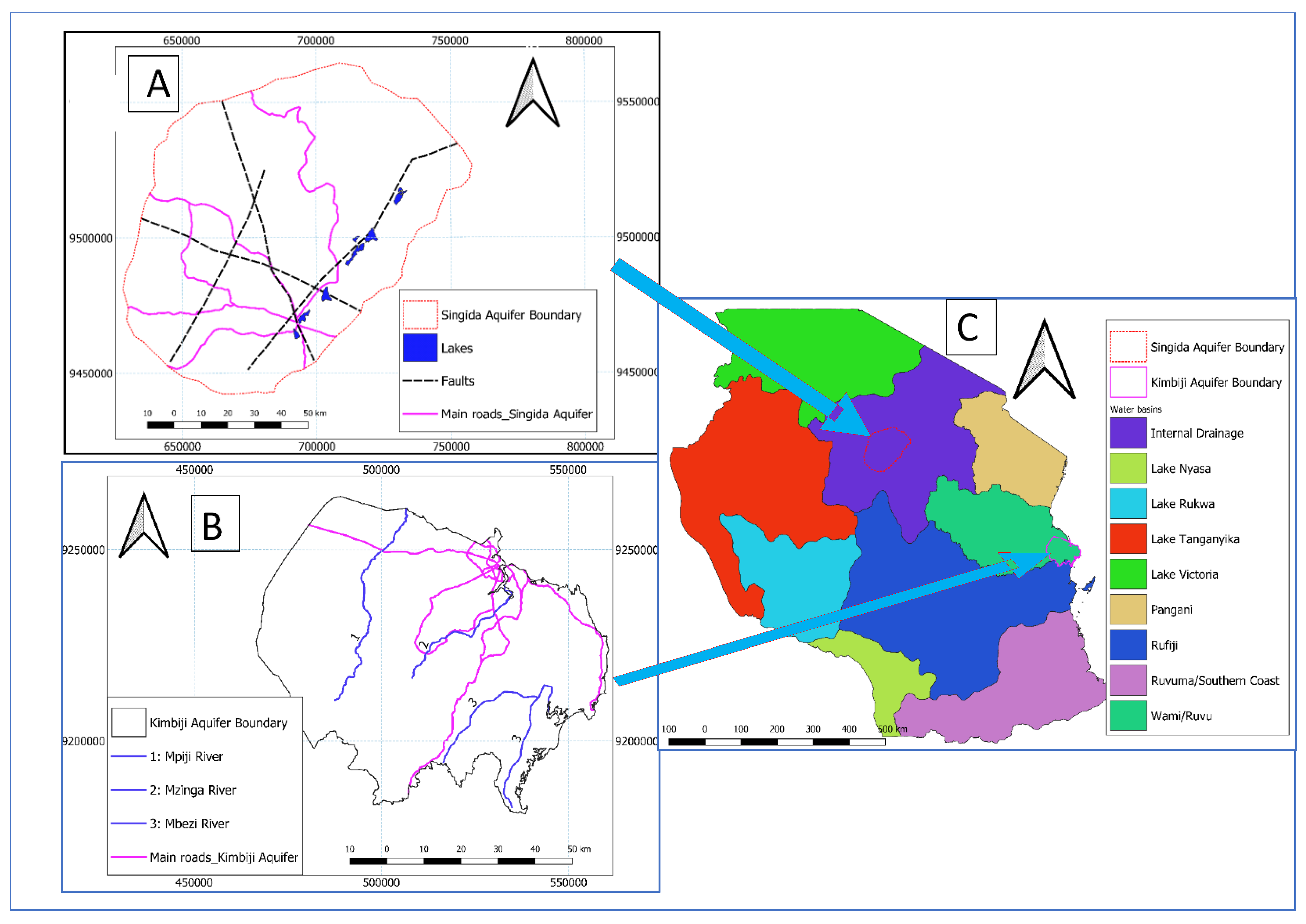
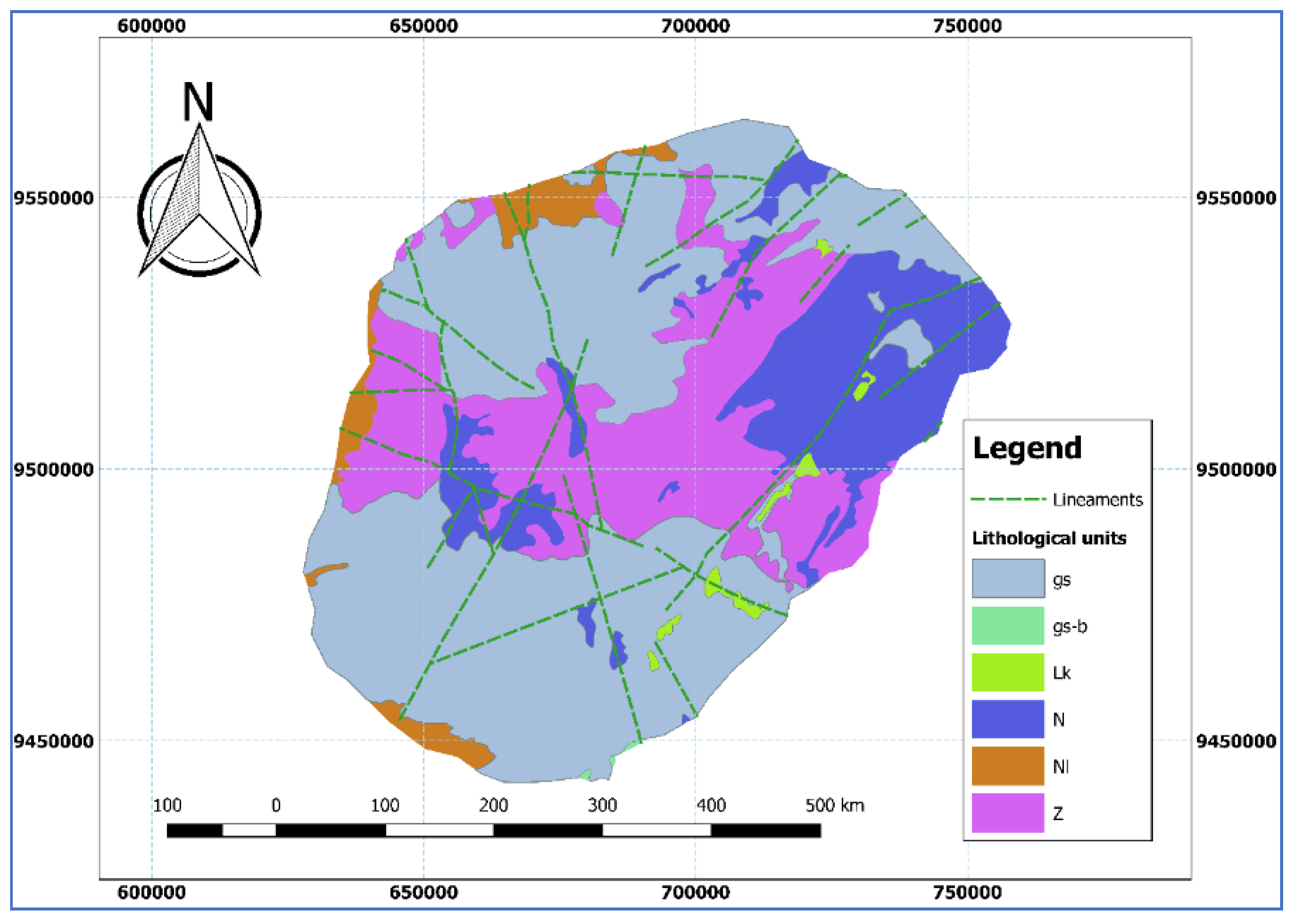
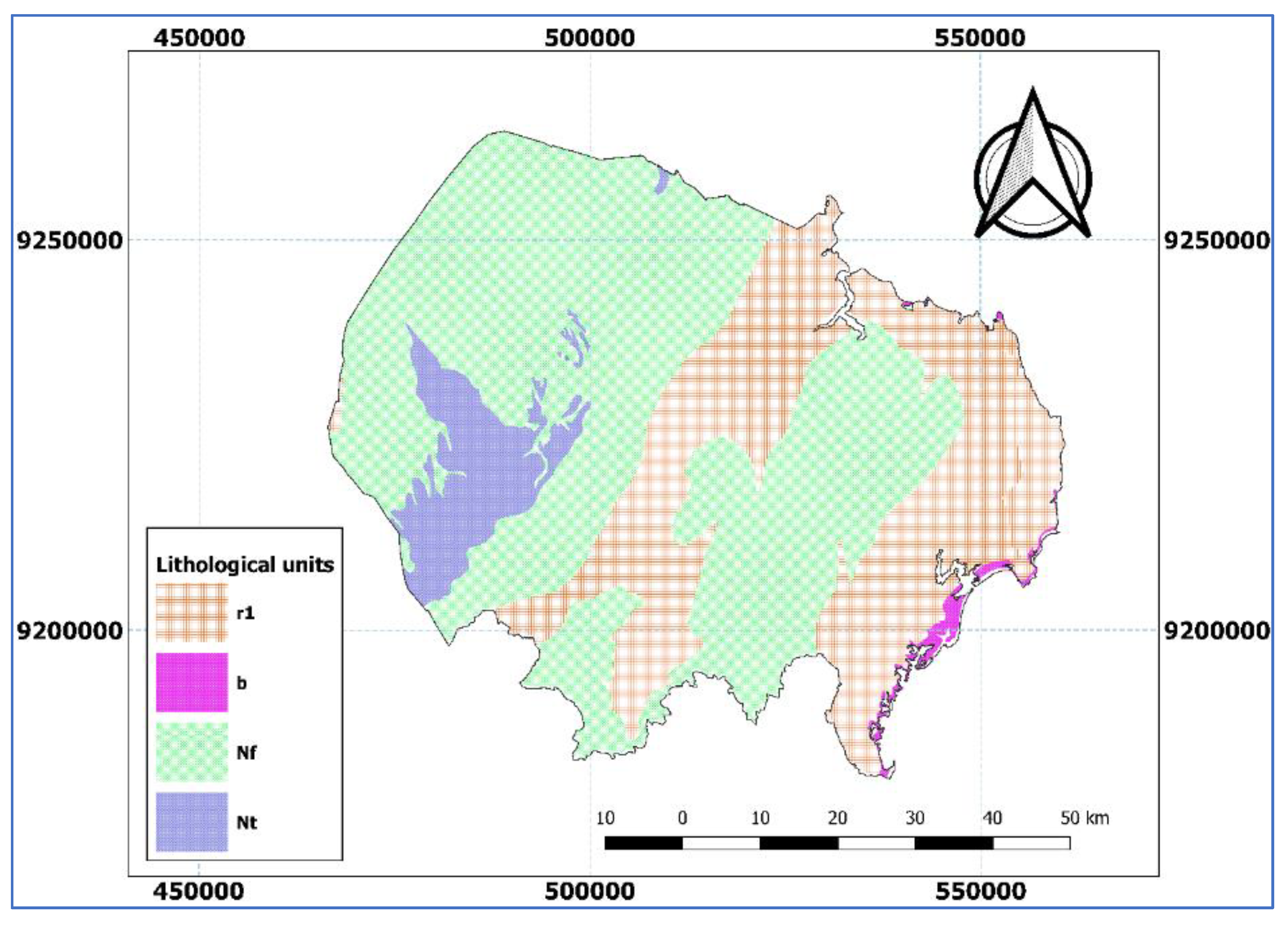
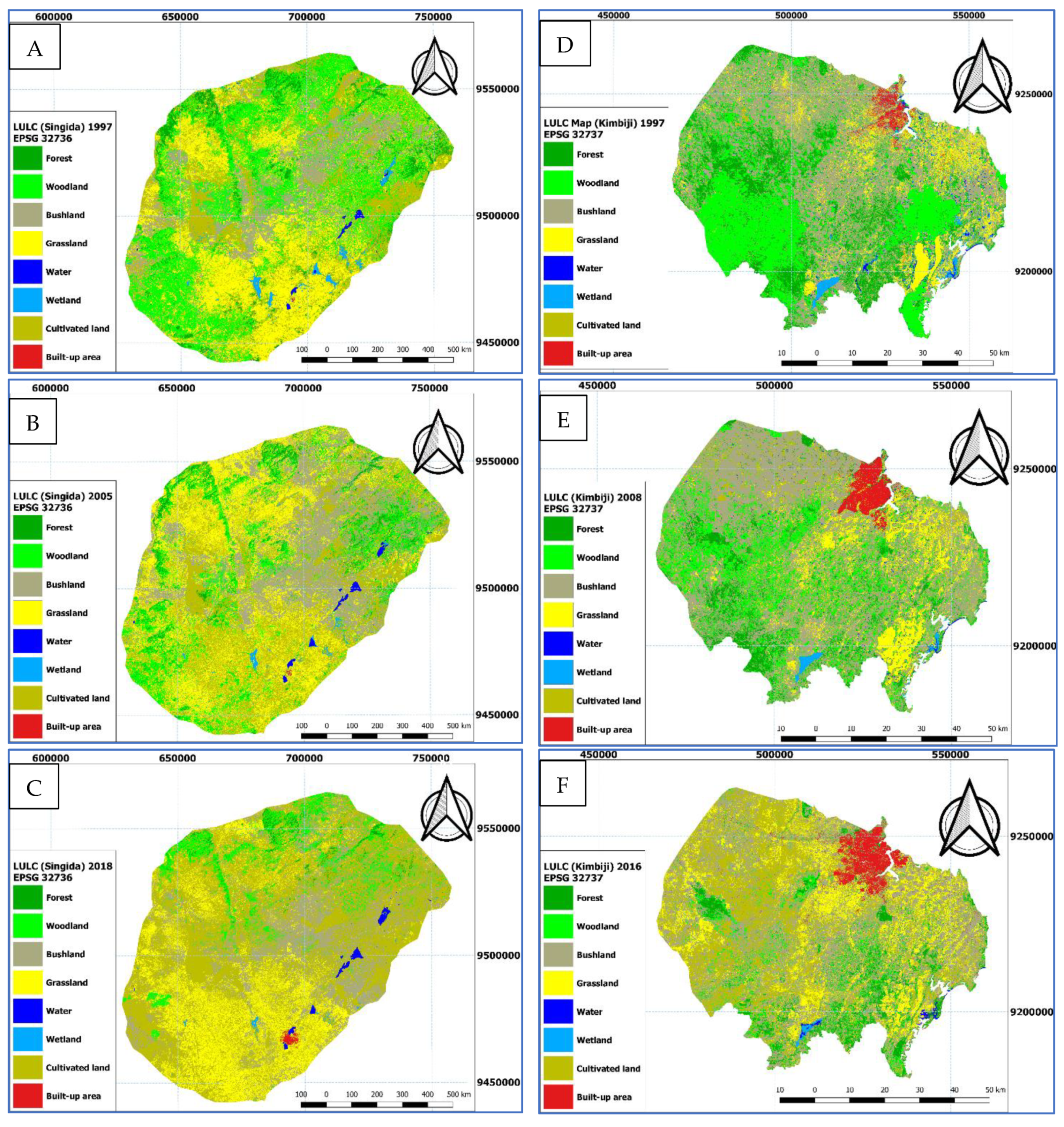

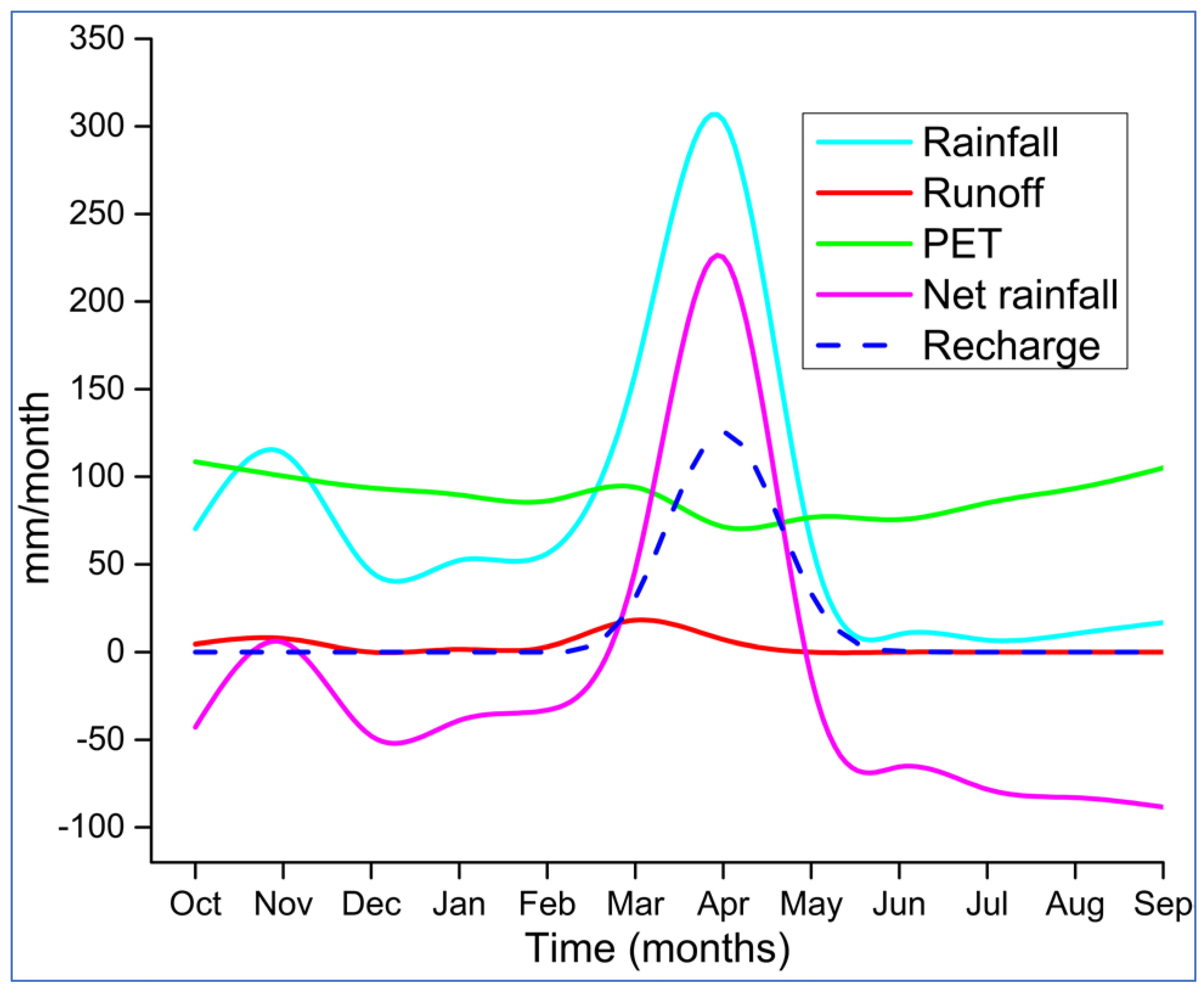
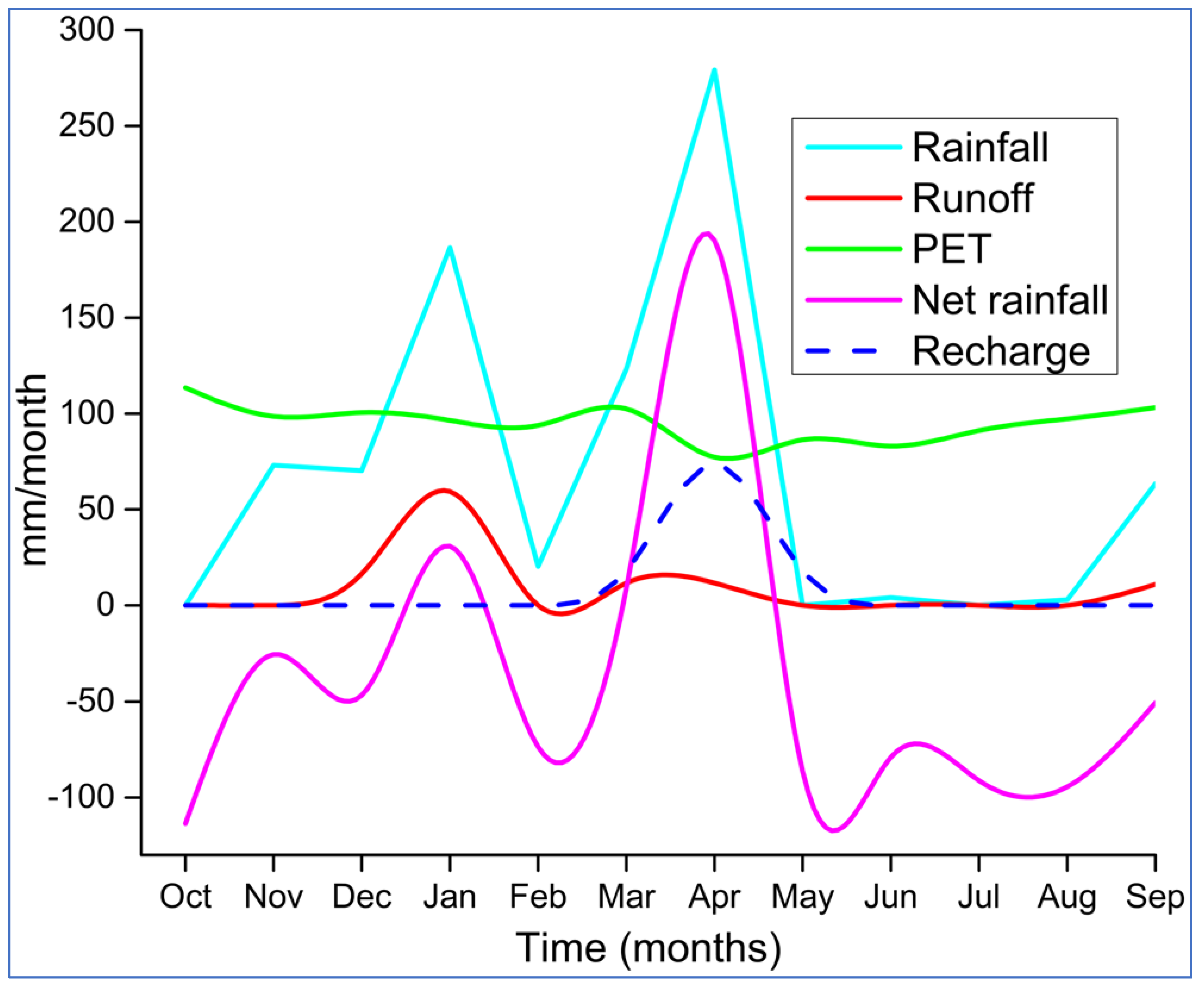
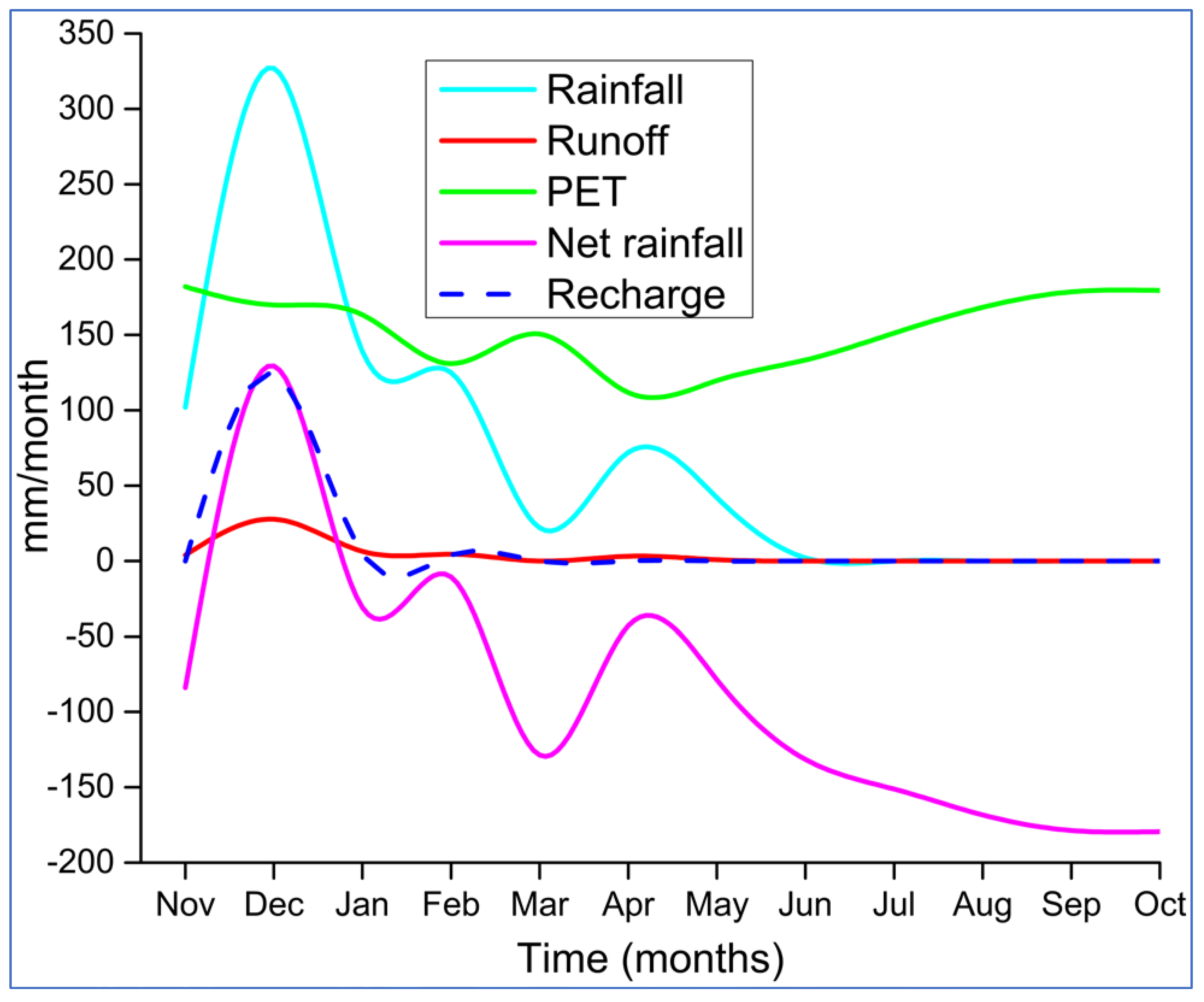


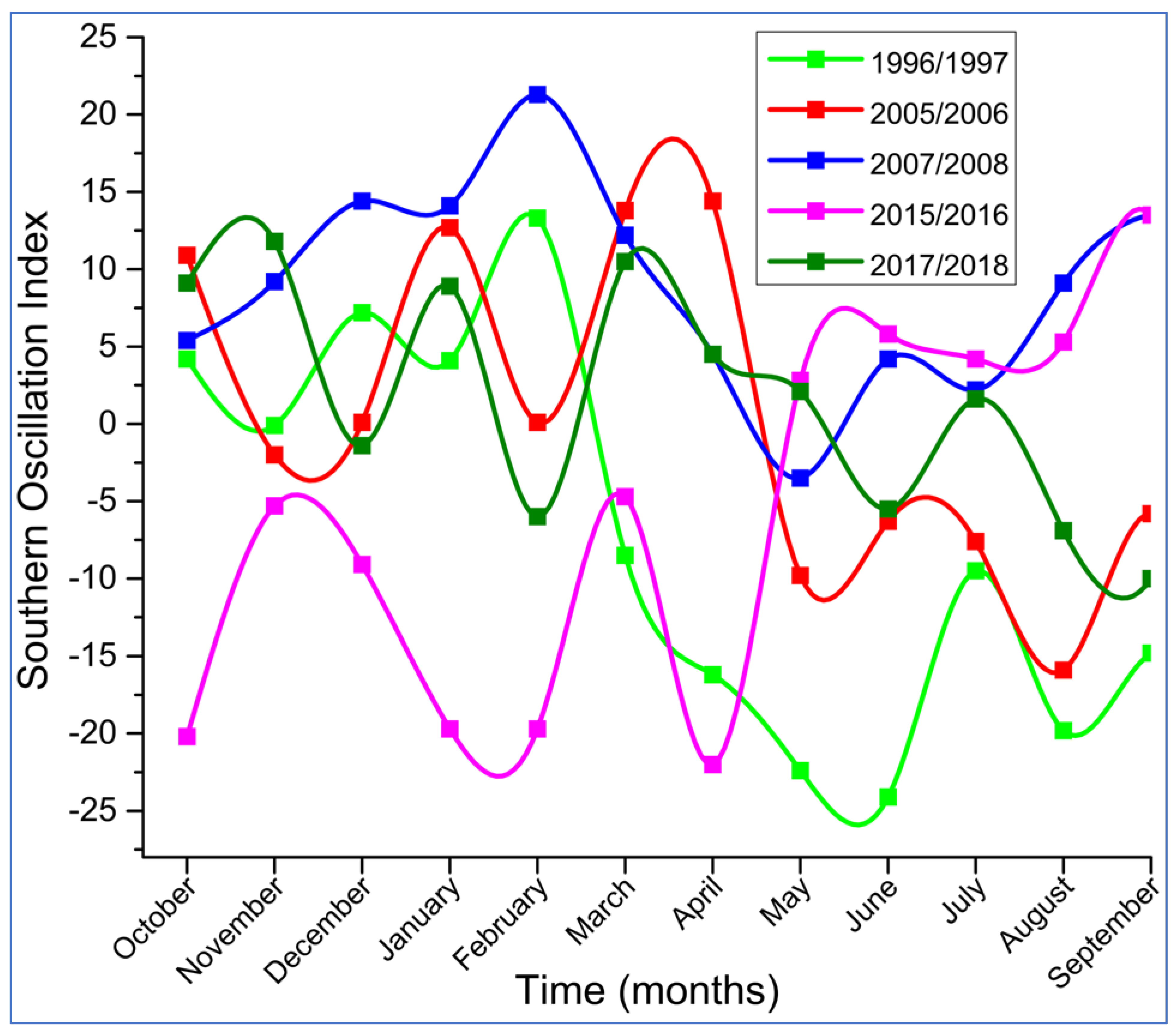
| Hydrologic Soil Group | Description | Final Infiltration Rate |
|---|---|---|
| Group A | ● Soils having high infiltration rates even when thoroughly wetted. A high rate of water transmission. These are typical of deep, well to excessively drained sands or gravels. | 8–12 mm/h |
| Group B | ● Soils having moderate infiltration rates when thoroughly wetted and a moderate rate of water transmission. Examples are moderately deep to deep, moderately well to well drained soils with moderately fine to moderately coarse textures. | 4–8 mm/h |
| Group C | ● Made up of soils having low infiltration rates when thoroughly wetted and a low rate of water transmission. This group is made up of soils with a layer that impedes the downward movement of water or soils of moderately fine to fine texture. | 1–4 mm/h |
| Group D | ● This group is composed of soils having very low infiltration rates when thoroughly wetted as well as a very low rate of water transmission. These are typical of clay soils, which have a high swelling potential. ● The group is also made up of soils with a permanently high-water table and soils with a clay pan or clay layer at or near the surface, or shallow soils over nearly impervious material. | less than 1 mm/h |
| AMC Group | Soil Characteristics | 5-Day Antecedent Rainfall (mm/5 Days) | |
|---|---|---|---|
| Dormant Season | Growing Season | ||
| I | The soils in the drainage basin are practically dry (i.e., the soil moisture content is at wilting point). | <13 | <36 |
| II | Average condition. | 13–28 | 36–53 |
| III | The soils in the drainage basins are practically saturated from antecedent rainfalls (Le. the soil moisture content is at field capacity). | >28 | >53 |
| Land Use/Cover Type | Hydrologic Condition | Curve Numbers for Hydrologic Soil Group | |||
|---|---|---|---|---|---|
| A | B | C | D | ||
| Woodlands and Forests | Poor | 45 | 66 | 77 | 83 |
| Fair | 36 | 60 | 73 | 79 | |
| Good | 30 | 55 | 70 | 77 | |
| Grassland for humid to subhumid areas | Poor | 68 | 79 | 86 | 89 |
| Fair | 49 | 69 | 79 | 84 | |
| Good | 39 | 61 | 74 | 80 | |
| Grassland for semi-arid areas | Poor | — | 80 | 87 | 93 |
| Fair | — | 71 | 81 | 89 | |
| Good | — | 62 | 74 | 85 | |
| Dryland shrubs/bushes | Poor | 63 | 77 | 85 | 88 |
| Fair | 55 | 72 | 81 | 86 | |
| Good | 49 | 68 | 79 | 84 | |
| Impervious areas (Built-up areas) | Paved parking lots, roofs, driveways, streets, and roads | 98 | 98 | 98 | 98 |
| Cultivated area (Row Crops), e.g., corn, sugar beets, soybeans | Good | 64 | 75 | 82 | 85 |
| Small Grain, e.g., wheat, barley, flax | Good | 60 | 72 | 80 | 84 |
| Wetlands | For swamps and wetlands with open water year-round such that at least 1/3 of the wetland is water, regardless of the soil type | 85 | 85 | 85 | 85 |
| Irrespective of soil type, this applies to wetlands with no open water and the calculations are for a 25-year frequency or shorter | 78 | 78 | 78 | 78 | |
| Water (Rivers, Reservoirs, and Lakes) | Rivers and reservoirs | 97 | 97 | 97 | 97 |
| Lakes | 100 | 100 | 100 | 100 | |
| Class Type | 1997 | 2008 | 2016 | |||
|---|---|---|---|---|---|---|
| Area (km2) | Area (%) | Area (km2) | Area (%) | Area (km2) | Area (%) | |
| Forest | 729 | 14.71 | 439 | 8.86 | 357 | 7.20 |
| Woodland | 1422 | 28.71 | 979 | 19.77 | 312 | 6.29 |
| Bushland | 2011 | 40.60 | 2440 | 49.26 | 2019 | 40.75 |
| Grassland | 530 | 10.70 | 527 | 10.63 | 809 | 16.32 |
| Water | 49 | 0.99 | 35 | 0.71 | 11 | 0.23 |
| Wetland | 106 | 2.13 | 27 | 0.55 | 9 | 0.18 |
| Cultivated land | 31 | 0.62 | 354 | 7.15 | 1235 | 24.92 |
| Built-up area | 76 | 1.54 | 152 | 3.07 | 203 | 4.09 |
| 4954 | 100 | 4954 | 100 | 4954 | 100 | |
| Class Type | 1997 | 2005 | 2018 | |||
|---|---|---|---|---|---|---|
| Area (km2) | Area (%) | Area (km2) | Area (%) | Area (km2) | Area (%) | |
| Forest | 586.40 | 5.63 | 463.49 | 4.45 | 144.12 | 1.38 |
| Woodland | 3039.31 | 29.17 | 1507.71 | 14.47 | 830.05 | 7.96 |
| Bushland | 1524.56 | 14.63 | 2380.89 | 22.85 | 2155.50 | 20.68 |
| Grassland | 2716.01 | 26.06 | 2882.39 | 27.66 | 2190.98 | 21.02 |
| Water | 26.77 | 0.26 | 46.18 | 0.44 | 51.48 | 0.49 |
| Wetland | 118.34 | 1.14 | 115.30 | 1.11 | 31.60 | 0.30 |
| Cultivated land | 2407.82 | 23.11 | 3022.95 | 29.01 | 4996.04 | 47.94 |
| Built-up area | 2.69 | 0.02 | 3.41 | 0.02 | 22.41 | 0.21 |
| 10,422 | 100 | 10,422 | 100 | 10,422 | 100 | |
| Land Cover Type | MC (km2) (1997–2008) | PC (%) (1997–2008) | ARC (km2) (1997–2008) | MC (km2) (2008–2016) | PC (%) (2008–2016) | ARC (km2) (2008–2016) | MC (km2) (1997–2016) | PC (%) (1997–2016) | ARC (km2) (1997–2016) |
|---|---|---|---|---|---|---|---|---|---|
| Forest | 290.0 | 40 | 24.2 | 82.0 | 20 | 9.1 | 372.0 | 50 | 18.6 |
| Woodland | 443.0 | 30 | 36.9 | 667.0 | 70 | 74.1 | 1110.0 | 80 | 55.5 |
| Bushland | −429.0 | −20 | −35.8 | 421.0 | 20 | 46.8 | −8.0 | 0 | −0.4 |
| Grassland | 3.0 | 0 | 0.3 | −282.0 | −50 | −31.3 | −279.0 | −50 | −14.0 |
| Water | 14.0 | 30 | 1.2 | 24.0 | 70 | 2.7 | 38.0 | 80 | 1.9 |
| Wetland | 79.0 | 70 | 6.6 | 18.0 | 70 | 2.0 | 97.0 | 90 | 4.9 |
| Cultivated land | −323.0 | −1040 | −26.9 | −881.0 | −250 | −97.9 | −1204.0 | −3880 | −60.2 |
| Built-up area | −76.0 | −100 | −6.3 | −51.0 | −30 | −5.7 | −127.0 | −170 | −6.4 |
| Land Cover Type | MC (km2) (1997–2005) | PC (%) (1997–2005) | ARC (km2) (1997–2005) | MC (km2) (2005–2018) | PC (%) (2005–2018) | ARC (km2) (2005–2018) | MC (km2) (1997–2018) | PC (%) (1997–2018) | ARC (km2) (1997–2018) |
|---|---|---|---|---|---|---|---|---|---|
| Forest | 122.9 | 0.2 | 13.7 | 319.4 | 68.9 | 22.8 | 442.3 | 75.4 | 20.1 |
| Woodland | 1531.6 | 0.5 | 170.2 | 677.7 | 44.9 | 48.4 | 2209.3 | 72.7 | 100.4 |
| Bushland | −856.3 | −0.6 | −95.1 | 225.4 | 9.5 | 16.1 | −630.9 | −41.4 | −28.7 |
| Grassland | −166.4 | −0.1 | −18.5 | 691.4 | 24.0 | 49.4 | 525.0 | 19.3 | 23.9 |
| Water | −19.4 | −0.7 | −2.2 | −5.3 | −11.5 | −0.4 | −24.7 | −92.3 | −1.1 |
| Wetland | 3.0 | 0.0 | 0.3 | 83.7 | 72.6 | 6.0 | 86.7 | 73.3 | 3.9 |
| Cultivated land | −615.1 | −0.3 | −68.3 | −1973.1 | −65.3 | −140.9 | −2588.2 | −107.5 | −117.6 |
| Built-up area | −0.7 | −0.3 | −0.1 | −19.0 | −557.2 | −1.4 | −19.7 | −733.1 | −0.9 |
| Accuracy Parameters | Kimbiji | Singida | ||||
|---|---|---|---|---|---|---|
| 1997 | 2008 | 2016 | 1997 | 2005 | 2018 | |
| Producer’s Accuracy (%) | 88.9 | 90.4 | 96.1 | 81.4 | 89.5 | 92.8 |
| User’s Accuracy (%) | 82.3 | 92.3 | 91.4 | 78.6 | 91.1 | 88.6 |
| Omission Error (%) | 11.1 | 9.6 | 3.9 | 18.6 | 10.5 | 7.2 |
| Commission Error (%) | 16.7 | 7.7 | 9.6 | 21.4 | 8.9 | 11.4 |
| Kappa Coefficient | 0.81 | 0.83 | 0.89 | 0.79 | 0.85 | 0.86 |
| Overall Accuracy | 87.3 | 88.0 | 86.5 | 85.7 | 89.2 | 93.6 |
| Land Cover Type | Land Cover Related CN II (Kimbiji) | Land Cover Related CN II (Singida) | Kimbiji | Singida | ||||
|---|---|---|---|---|---|---|---|---|
| 1997 | 2008 | 2016 | 1997 | 2005 | 2018 | |||
| CNi | CNi | CNi | CNi | CNi | CNi | |||
| Forest | 55 | 73 | 8.09 | 4.88 | 3.96 | 4.11 | 3.25 | 1.01 |
| Woodland | 60 | 77 | 17.23 | 11.86 | 3.77 | 22.46 | 11.14 | 6.13 |
| Bushland | 72 | 72 | 29.23 | 35.47 | 29.34 | 10.53 | 16.45 | 14.89 |
| Grassland | 69 | 71 | 7.39 | 7.34 | 11.26 | 18.50 | 19.64 | 14.93 |
| Water | 97 | 100 | 0.96 | 0.69 | 0.23 | 0.26 | 0.44 | 0.49 |
| Wetland | 85 | 85 | 1.81 | 0.47 | 0.15 | 0.97 | 0.94 | 0.26 |
| Cultivated land | 75 | 75 | 0.47 | 5.36 | 18.69 | 17.33 | 21.75 | 35.95 |
| Built-up area | 98 | 98 | 1.50 | 3.01 | 4.01 | 0.03 | 0.03 | 0.21 |
| Weighted curve number | 66.68 | 69.08 | 71.41 | 74.19 | 73.64 | 73.87 | ||
| Hydrologic Year (PET Method) | Rainfall (mm/Year) | Runoff (mm/Year) | PET (mm/Year) | Recharge (mm/Year) | Aridity Index |
|---|---|---|---|---|---|
| 1996/1997 (HS) | 912.5 | 23.1 | 1046.1 | 258.5 | 0.9 |
| 1996/1997 (PM) | 912.5 | 23.1 | 1156.5 | 214.4 | 0.8 |
| 2007/2008 (HS) | 907.6 | 42.2 | 1138.3 | 206.8 | 0.8 |
| 2007/2008 (PM) | 907.6 | 42.2 | 1079.5 | 190.0 | 0.8 |
| 2015/2016 (HS) | 823.1 | 109.9 | 1204.3 | 128.7 | 0.7 |
| 2015/2016 (PM) | 823.1 | 109.9 | 1143.9 | 109.6 | 0.7 |
| Hydrologic Year (PET Method) | Rainfall (mm/Year) | Runoff (mm/Year) | PET (mm/Year) | Recharge (mm/Year) | Aridity Index |
|---|---|---|---|---|---|
| 1996/1997 (HS) | 831 | 46.6 | 1839.4 | 132.7 | 0.45 |
| 1996/1997 (PM) | 831 | 46.6 | 2083.3 | 107.1 | 0.40 |
| 2004/2005 (HS) | 550 | 12.2 | 1814.7 | 40.3 | 0.30 |
| 2004/2005 (PM) | 550 | 12.2 | 2053.6 | 20.4 | 0.27 |
| 2017/2018 (HS) | 551.9 | 21.9 | 1710.2 | 45.9 | 0.32 |
| 2017/2018 (PM) | 551.9 | 21.9 | 1875.4 | 27.5 | 0.29 |
Publisher’s Note: MDPI stays neutral with regard to jurisdictional claims in published maps and institutional affiliations. |
© 2021 by the authors. Licensee MDPI, Basel, Switzerland. This article is an open access article distributed under the terms and conditions of the Creative Commons Attribution (CC BY) license (https://creativecommons.org/licenses/by/4.0/).
Share and Cite
Mussa, K.R.; Mjemah, I.C.; Machunda, R.L. Natural Groundwater Recharge Response to Climate Variability and Land Cover Change Perturbations in Basins with Contrasting Climate and Geology in Tanzania. Earth 2021, 2, 556-585. https://doi.org/10.3390/earth2030033
Mussa KR, Mjemah IC, Machunda RL. Natural Groundwater Recharge Response to Climate Variability and Land Cover Change Perturbations in Basins with Contrasting Climate and Geology in Tanzania. Earth. 2021; 2(3):556-585. https://doi.org/10.3390/earth2030033
Chicago/Turabian StyleMussa, Kassim Ramadhani, Ibrahimu Chikira Mjemah, and Revocatus Lazaro Machunda. 2021. "Natural Groundwater Recharge Response to Climate Variability and Land Cover Change Perturbations in Basins with Contrasting Climate and Geology in Tanzania" Earth 2, no. 3: 556-585. https://doi.org/10.3390/earth2030033





